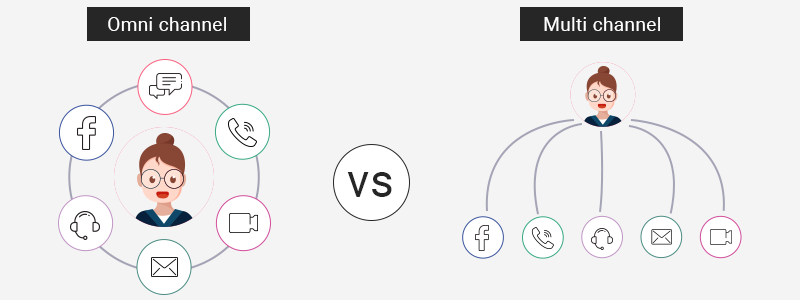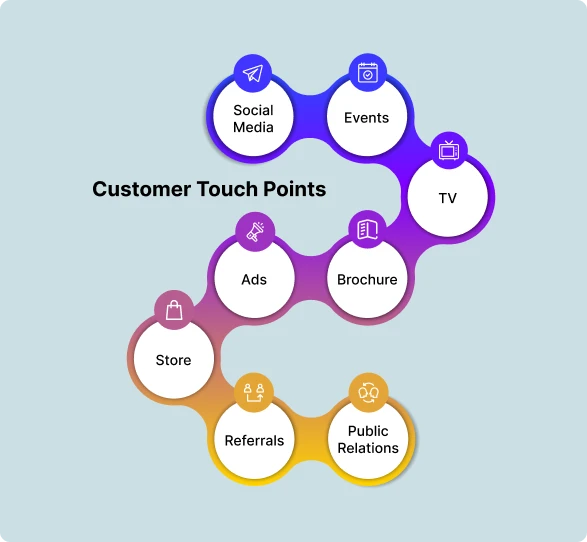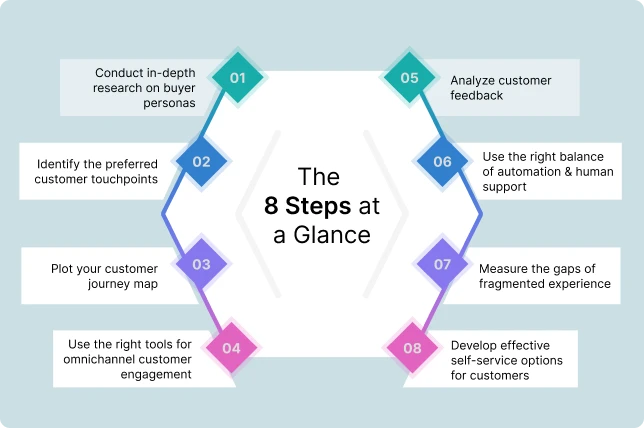Omnichannel Customer Experience: How to Create & Examples
- June 10, 2020
- 30 mins read
- Listen

Table of Content
Today, your customers have more ways to connect with your brand, whether through social media platforms, your website, a mobile app, or in-store visits. For instance, a customer might start by browsing a specific product on your website, explore further on your mobile app, and finally visit your physical store to make the purchase. However, if these touchpoints aren’t properly integrated, you may lack crucial information and offer inconsistent details to the customer. This can be frustrating for both the customer and your company. Such gaps can be costly, eroding customer trust and impacting your bottom line.
The solution? Omnichannel customer experience. By integrating all customer touchpoints into a unified strategy, omnichannel ensures that every interaction, whether online or offline, is connected and consistent. According to a study by Forbes, companies with the most effective omnichannel customer strategies retain 89% of their customers
So, how would businesses plan their strategy to deliver a superior omnichannel consumer experience (CX)? Before diving more into the details, let us understand what is omnichannel customer experience and why it matters.
What is Omnichannel Customer Experience (CX)?
In simple terms, omnichannel customer experience (CX) means streamlining all the customer interactions across multiple touchpoints in a unified way to deliver a consistent brand experience.
The digital omnichannel strategy involves multiple channels approach for sales, customer support, and marketing. It focuses on delivering a cohesive customer experience irrespective of the channel used by customers to reach out to your business.
If seen from the customer’s standpoint, every interaction with your business should be part of a singular experience. It means it should not be siloed or repetitive as it happens with multi channel customer support. Having a seamless journey across all channels, both online and offline is the key to provide a consistent omnichannel experience.
Omnichannel is complex, and many factors contribute to a customer’s evaluative judgment of perceived omnichannel customer experience (OCX). You can check out the peer-reviewed scientific journal article that discusses the concept of OCX and how to measure omnichannel CX.
It illustrates the OCX framework with nine prime focus areas for delivering better CX: social communications (i.e., customer reviews), value (i.e., products and pricing), personalization, customer service, consistency product availability & prices across channels, information safety, delivery, product returns, and loyalty programs.
Benefits of Omnichannel Customer Experience
Great customer experience is the by-product of an effective and well-designed omnichannel ecosystem. To achieve it, businesses must understand customer journeys across devices and channels. Customers who use more channels to communicate are more valuable to the companies as research shows that they spend an average of 4% more in physical stores and 10% more than online single-channel customers.
Adopting an omnichannel approach in your business operations—including customer service, marketing, advertising, and sales strategies—offers a wide range of benefits, such as:
Better View of the Customer Journey
An omnichannel consumer experience strategy gives you a bird’s-eye view of your customer’s journey. You can monitor the whole buying journey throughout all the touchpoints. It streamlines all the interactions under one platform and provides insights into the right actions for improving your business.
Higher Customer Retention
An omnichannel CX strategy allows customers to connect with your brand through their preferred channels while ensuring a seamless transition within the same interaction. With all channels integrated, you can provide consistent information across all touchpoints, creating a positive experience that leads to higher customer satisfaction. The more satisfied your customers are, the more likely they are to stay loyal to your brand over time.
Boost Customer Lifetime Value (CLTV)
Omnichannel customers are 30% more valuable to your business throughout their lifetime. An omni CX approach makes easier for customers getting in touch with the company simple and intuitive. When a business plans to deliver a consistent response, they also choose your business for a lifetime.
Efficient Customer Service
You can conveniently store all customer chat interactions from different channels in one place. This means when customers contact the support team for help, they won’t have to repeat previous conversations or provide references. The agents can quickly access all the relevant details in a single database, allowing them to assist more efficiently.
Omnichannel Customer Experience Vs. Omnichannel Marketing
Usually, there is a conflict between omni channel marketing and omnichannel customer experience (CX).
Omni-channel marketing ensures that messaging and branding are consistent among channels. It acknowledges and addresses the customers across their preferred platforms to deliver a smoother buying experience at every stage of their journey. It also includes merging the different channels together (for example, social media, website) for promotional experiences.
Different Types of Omnichannel Engagement
Omnichannel journeys refer to the seamless integration of various channels through which customers interact with a brand, ensuring a cohesive and consistent experience. whether your customers prefer shopping for clothes online or in a physical store, understanding and integrating their preferences across various touchpoints is key. By doing so, you can create a seamless omnichannel experience that not only attracts but also retains customers, ensuring the sustained success of your brand.
There are different types of Omnichannel customer journeys. Lets deep dive to know more about it.
1. Fully Digital- Without Human Interaction
In today’s digital age, the customer journey can be entirely virtual, requiring no human interaction. This fully digital journey begins when potential customers become aware of a brand’s offerings through a targeted medium, such as social media channels, online ads, or email campaigns. Intrigued by what they see, they navigate to the brand’s website, browse through categories, read product descriptions, and view high-quality images or videos. Advanced search functionalities, filters, and personalized recommendations enhance the omnichannel shopping experience, making it easier for them to find exactly what they’re looking for.
The customer relationship doesn’t end with the sale. Post-purchase engagement is also crucial for maintaining a strong connection with the brand. This is achieved through interactions on the brand’s app or website, where customers can manage their orders, initiate returns, or address any complaints digitally. A robust digital infrastructure ensures that these processes are smooth and hassle-free, enhancing customer satisfaction.
2. Blending Digital and Physical Interactions
The combination of digital and physical interactions creates a seamless customer journey that leverages the strengths of omnichannel marketing customer experience both online and offline channels. This approach allows customers to interact with a brand in the way that best suits their needs and preferences, enhancing their overall experience.
Imagine a customer who starts his journey by browsing an online store for dresses. She might explore the website, use virtual try-on tools, and read reviews. However, she may prefer to visit a physical store to feel the fabric and ensure a perfect fit. After making a purchase in-store, the customer can still engage digitally by accessing her purchase history, managing returns, and using loyalty points through the brand’s app or website.
3. Blending Digital and Virtual Assistant Interactions
Integrating digital channels with virtual assistant interactions creates a seamless and efficient customer journey that leverages the strengths of both technologies. This approach allows customers to access information and support in the way that best suits their needs, enhancing their overall experience.
This type of omnichannel customer journey became popular in the post-pandemic era, as consumers increasingly sought assistance through helplines, video calls, live chat or phone calls to make purchasing decisions.
Channels Involved in Omnichannel Customer Engagement
In Latin, the term “Omni” means all. However, this doesn’t imply that you must use every possible channel to deliver an optimized omnichannel CX. Omnichannel experience encompasses a wide range of channels, including:
- Websites
- Mobile apps
- Social media
- Emails
- SMS/ other messaging apps
- Physical stores
- Kiosks
- Live chat
- Voice calls
- Video calls
- Voice assistance and etc
Multi Channel vs Omnichannel Experience
There are some obvious differences between customer engagement strategies. According to HubSpot, “All omni-channel experiences will use multiple channels, but not all multi-channel experiences are omni-channel.”
The key difference is that omnichannel businesses streamline all customer interactions under a single platform. It means the planning, purchasing, marketing, customer relationship management seamlessly affect all your online and offline channels.
On the other hand, in the multi channel customer care approach, every channel is treated individually and is managed in a unique manner by implementing different strategies. Thus, a multichannel customer care strategy does not focus on creating a consistent shopping experience.
Comparing omnichannel vs multichannel based on the customer experience statistics helps to understand how you can integrate the touchpoints together to provide a consistent experience of a unified journey.
8 Steps for Creating a Successful Omnichannel Customer Experience Journey
In order to build a digital omnichannel customer experience, there are different strategies. By implementing the strategies rightly, you get rid of siloed engagements and deliver a better experience. Businesses who make omnichannel customer service as their focal point are able to boost customer satisfaction and retention significantly.
Let us discuss the different ways comprehensively.
1. Conduct In-depth Research in Buyer Personas
Businesses who lack a solid customer experience (CX) strategy based on deep customer insights complain that they don’t understand their customers. Alternatively, those who develop omni channel CX plans grounded in a survey, demographic, and behavioral data have much better outcomes.
More and more companies exceed revenue and lead goals have documented personas. Customer personas provide tremendous value to your business by representing different segments that make up your target audience. Using data-driven research is the key to understanding who is your target audience and what motivates them to purchase your products and services.
The most crucial element of a persona’s influence is an improvement to customer experiences. The use of a well-constructed persona results in more effective marketing and sales.
Here is how omnichannel integration helps in creating buyers to deliver a better customer experience:
- Improve value propositions that align with the desired needs of the customers.
- Increase profits by providing customers with what they are looking for.
- Provide a better understanding of buyers, their needs, and how to fix them.
- Accelerate lead conversions by aligning your teams around a customer-centric vision.
2. Identify the Preferred Customer Touchpoints
Always remember the old retail adage: “Customers remember the service a lot longer than they remember the price.” – Lauren Freedman
Identifying your customer touchpoints enables you to have a better understanding of what your customers are feeling at each stage of their buying process with your company and through different mediums and channels.
It gives you insights into what customers expect and how you can exceed those expectations in order to create “WOW Moments”. Once you have identified key points where your customers connect with you, you will be better placed to create enhanced experiences for them and devise effective marketing strategies.
How identifying touchpoints help to improve omnichannel consumer experience:
- Understand customers and engage their way – Knowing the preferred touchpoints helps to be actively available across the channels for real time assistance.
- Personalize your interaction – You can personalize your interaction at the identified touchpoints and set excellent customer service experience examples.
3. Plot Your Customer Journey Map
A customer journey map is a tool that tells the story of a customer’s experience of interacting with your brand. A typical customer journey map begins with the first exposure that the customer has with your brand or product and follows their engagement through to the point of sale and beyond.
Developing a customer journey strategy begins with mapping the steps the consumer takes on the route to purchase. This mapping process can be complex as customers engage with touchpoints across multiple channels. Increasing the use of mobile and social has also multiplied the number and frequency of contacts during a typical journey.
Applying the customer experience statistics and analytics to the customer journey map can help your business better understand customer interactions and bridge the gap between devices and channels for a unified and satisfying omnichannel consumer experience.
4. Use the Right Tools for Omnichannel Customer Engagement
It is not possible to deliver seamless experiences across diverse touchpoints without the right technology to enable it. Building the right technology stack to deliver a seamless experience across channels is important to achieving success with omnichannel customer engagement.
From a customer being able to switch between your mobile app and a chat with a bot smoothly, businesses need to use the right digital tools & technology that allows data flow at ease in real-time, to serve customers on their preferred touchpoints.
Key tools that can be used to enhance omnichannel customer experience at different touchpoints.
- Chatbots – Deploy chatbots to engage with customers 24×7 and provide real time answers for simple queries.
- Live Chat – Provide real time assistance to the sales and support related queries with live chat and improve customer satisfaction.
- Live Engagement Tools – With co-browsing, collaborate with your customers by sharing their browsers to guide them through a complex form fill-up. With a video based call center, you can identify issues faster and deliver personalized solutions.
By using digital tools and customer engagement strategies, provide real-time response, and effective solutions. You can strengthen your relationship with existing customers and increase brand loyalty.
5. Analyze Customer Feedback
Customer feedback is a blessing in disguise for businesses as it brings in golden opportunities that can help you to improve the omnichannel customer journey. Delivering superior service means delivering real time support by being where your customers are and giving them an easy way to share feedback.
Omni channel customer service approach allows brands to engage with customers through every channel and capture feedback at every customer touchpoint. The different ways to ask for customer feedback are website, social media, emails, in-app, reviews, etc.
Here is how analyzing customer feedback can improve the omni channel CX.
- Use customer feedback to develop an in-depth understanding of your customers to serve them better.
- Implement a system to help you collect feedback, analyze it, and act on it regularly
- Reduce friction and solve your customers’ specific problems and challenges
6. Use the Right Balance of Automation & Human Support
One vital aspect of omnichannel customer experience management is the right balance of automation, and human understanding: Customers expect brands to understand them with intelligent technology along with authentic and empathetic human experiences.
Choosing the right approach needs a deep understanding of using live chat vs chatbot by learning the pros and cons of both channels. The balanced support approach manages the resources on priority tasks. You can use chatbots at the primary stage and put human support for complex conversations.
Designing both into the overall customer service experience design helps maintain the appropriate balance, which can become a real differentiator for the brand. Knowing when a conversation needs to move from a bot to a human, for example, knowing when to appease an angry customer with an apology versus an offer, and so on. is how the balance manifests.
7. Measure the Gaps of Fragmented Experience
Identifying the gaps in fragmented experiences is a vital part of improving omnichannel customer experience. Delivering better CX is always work in progress and as customer habits keep evolving, so should be the experience brands aim to deliver.
Earlier, the concept of providing customer service over social media didn’t exist. And today, it is one of the major platforms to provide immediate assistance to customers while also scoring brownie points in full view of the entire customer community.
Measuring the gaps provides you insights into what actually your customers are looking for and takes the right steps of improvement to deliver a better omnichannel customer experience.
Pro tip: Keep an eye out for any data gaps between various channels, as that may force customers to refer to different sources or channels for one purpose, making them lose time, causing inconvenience, and ultimately spoiling their overall experience.
8. Develop Effective Self-Service Options for Customers
Businesses are recognizing the benefits of self-service portals for improving the overall brand experience. As customers want instant answers to their questions or problems. In fact, response time is the most important attribute of the customer experience.
Self-service portals provide customers with instant access to information and save valuable time and business resources. You can create a content hub in the form of tutorials, manuals, videos to help customers to solve their problems on their own. Here are the key benefits of self-service portals:
- Use Personalized Information – The self-service portal can maintain a record of the products or services purchased and display what is relevant to them. You can identify customer issues and take adequate steps to address them.
- More Positive Recommendations – Such portals help to strengthen brand reputation by creating positive client interactions.
- Educate Customers – You can expand your customers’ knowledge & skills they require for solving other similar issues in the future.
Examples of Omni channel Marketing
At its core, omnichannel customer experience (CX) refers to brands that have the approach to deliver an integrated shopping experience. The customer has a seamless experience of an easy transition from shopping online on a desktop or mobile device, to the phone, or a brick-and-mortar store. Omni integration fosters a greater sense of familiarity with the brand, which impacts positive brand image and retention rates.
Here are two examples of omnichannel integration and innovation in the way to deliver a great consumer experience.
1. Omni Channel Retail – Crate & Barrel
Crate & Barrel understood the fact that usually consumers switch through several different devices prior to completing purchases. They moved to omnichannel settings to capitalize on the customer behavior of the toggling to devices.
Whenever a customer is logged into their account, the app saves their shopping cart and browsing data so they can access this information across multiple devices. It helped customers to take up where they left off in the shopping process which greatly reduces the shopping cart abandonment rate, and Crate & Barrel has reaped great returns and delivered a great omni channel shopping experience.
Achievements
- Crate & Barrel’s implementation of an omnichannel customer experience strategy resulted in a 10% revenue increase from the newly improved mobile and web stores.
- Going further in the path of innovation, they released their 3D Room Designer feature, allowing consumers to virtually place an item into their home before purchasing.
2. Omni Channel Retail – Oasis Fashion
Oasis, a highly acclaimed UK based fashion retail brand operates online as well as physical stores globally. It was really impressive that they integrated both online and offline stores together to provide an all-round omnichannel retail shopping experience to its customers.
The store realized the core part of moving to an omnichannel customer care approach was to:
- Figure out all the online and offline places your customers hang out.
- Create touchpoints in the identified places and make the touchpoints shoppable.
And their touchpoints were not just the stand-alone sales or support channels. They integrate with each other to bring a more unified experience.
Key learnings:
- Make things as simple as possible for your customers. Oasis separated out their personal shopping section of their site into occasions to attract their customers to explore the section more.
- Use social media to encourage your customers. Oasis encouraged exploration of their site through their social channels. They used specific product item codes to entice users to explore more about each product.
3. Restaurant: Chipotle
Chipotle Mexican Grill is a popular fast-casual restaurant chain known for its focus on fresh ingredients and customizable menu options. Chipotle excels at creating a seamless customer experience through various channels. Their online platform and mobile app make ordering easy, allowing you to place an order from anywhere and have it ready for pickup when you arrive. If you sign up for an account, you can save your favorite orders, making the process even quicker and more convenient.
Key Learning:
- Chipotle provides multiple options for customers to receive their orders, including their website, mobile app, and in-store pickup, ensuring maximum convenience.
- Their system makes it easy to place orders from anywhere and have them ready when you arrive.
- Additionally, Chipotle lets customers save their favorite orders for quicker and easier future purchases.
4. Coffee House Chain: Starbucks
Starbucks is famous for its premium coffee drinks, beverages, a variety of other drinks and quick meals. Starbucks has developed an omnichannel experience that not only builds strong connections with customers but also encourages them to return for more. Their popular mobile app allows customers to place orders, pay and select a physical store for pickup. The app also provides access to special offers and promotions, allowing customers to earn points that can be redeemed for free drinks.
Starbucks has also partnered with Spotify to create a unique “music ecosystem.” This feature lets Spotify Premium subscribers use the Starbucks app to discover and enjoy the music playing in-store, whether they are at a Starbucks location or not.
Key Learnings:
- By integrating multiple channels (mobile app, physical stores, and digital platforms) Starbucks has created a smooth, cohesive experience that enhances customer satisfaction and convenience.
- By implementing various loyalty programs, like Starbucks offering redeemable points for free drinks, you can boost customer engagement and encourage repeat purchases.
- Collaborating with other complementary brands, like Starbucks did with Spotify, can add unique value to the customer experience and differentiate your brand from competitors.
5 Ways to Improve Omnichannel Customer Experience
Omnichannel isn’t just about integrating all your customer touchpoints to run marketing campaigns; it’s about ensuring that all your customer communication platforms are seamlessly connected, delivering consistent information across all channels. To provide the best omnichannel customer experience, here are some tactics to follow:
1. Engage with Your Customers at Every Stage
Whether through social media, mobile apps, website or physical stores, customers are always interacting with brands. By offering more interactive experiences, brands can increase their visibility too, drive revenue, and foster a loyal customer base. You can engage with them in multiple ways like launching loyalty programs, arranging various social media contests, etc. Trust me, the more you engage with them the more they will get connected to your brand.
Pro Tips:
- Create fun and engaging contests on your social media platforms.
- Prompt customers to like, share, or comment on your brand’s posts.
- Encourage customers to share their own content related to your brand, such as reviews, photos, or testimonials.
- Use personalized messages and offers based on customer preferences and behavior.
2. Opt for Mobile Optimization
Research indicates that almost 84% of customers use their phones while shopping in physical stores. Now you can understand the importance of mobile devices in their shopping journey. If your communication platforms aren’t mobile-optimized, you are at risk of losing engagement and potential sales.
Pro Tips:
- Create content that is easily readable on smaller screens.
- Optimize your website and app to load quickly on mobile devices.
- Design your site with touch-friendly navigation and buttons.
- Simplify the checkout process for mobile users.
- Add click-to-call buttons to your mobile site or app, allowing users to easily contact you with a single tap.
3. Analyse Your Content
Understand how your marketing content fits into the omnichannel customer journey. Analyzing your content helps determine which types—informative, educational, or engaging—are most effective in different contexts. Informative content is especially crucial, as it provides essential details related to business contact information. When conducting your analysis, make sure that all informational content is accurate and up-to-date.
Pro Tips:
- Focus on providing clear, accurate, and relevant information.
- Use various analytics tools to measure how different content types perform across channels.
- Make sure all content, especially informational, is easily accessible and readable on mobile devices.
- Gather feedback from customers about the usefulness and clarity of your content.
- Regularly test different content types and formats to see which are most effective in engaging and informing your audience.
4. Offer Personalized Customer Service for better engagement
You may have adopted omnichannel strategies to better serve your customers, but the key to making them feel valued and satisfied still lies in providing excellent customer service. Omnichannel efforts streamline customer service by giving you a unified view of all interactions in one place. This means your agents don’t need to ask customers for background information—they can see everything from past interactions to the entire buying journey in real-time, enabling them to deliver personalized service.
Pro Tips:
- Equip your customer service agents with the tools and knowledge they need to navigate the omnichannel platforms efficiently.
- Use the data consolidated from different touchpoints to tailor interactions based on each customer’s preferences, previous purchases, and communication history.
- Regularly review customer interactions across channels to identify common issues, trends, or areas for improvement.
- After resolving issues, ask for customer feedback to understand their experience and identify any gaps in service.
5. Omnichannel Experience Should be Seamless for all including the Team
You might be providing a seamless omnichannel experience for your customers, allowing them to easily communicate with you across multiple platforms. However, it’s equally important that your team can connect with customers in the same effortless way. This means that all communication touchpoints should be integrated, giving your team centralized access to all customer information. With an omnichannel interface, your team should be able to manage interactions efficiently and provide a more cohesive service experience.
Pro Tips:
- Use integrated platforms that allow your team to access and manage customer interactions from a single interface.
- Train your team to handle customer interactions across multiple channels.
- Ensure that your internal communication is streamlined.
- Establish feedback loops where team members can share their insights about customer pain points and successes across different channels.
6. Transition from online to Offline Should be Easy
Many customers start their shopping journey by searching for products online, and exploring different retailer websites and marketplaces. Some may even visit the physical stores to get a closer look at the products. Companies need to ensure that the transition between online and offline experiences is smooth and effortless.
Whether customers choose to buy online or in-store, you need to have the right information to serve them effectively and ensure consistent messaging across all channels. Providing options like Buy Online, Pickup In-Store (BOPIS) can also enhance their experience, allowing them to shop online and conveniently pick up their orders at a nearby store.
Pro Tips:
- Ensure that the product details, prices, and availability are consistent across both online and in-store.
- Create unified customer profiles that track interactions across both channels.
- Make sure the checkout process is simple and efficient, both online and in-store.
- Use technology in-store, such as mobile apps, tablets, or kiosks, to provide customers with additional product information, reviews, or availability updates.
- Ensure that inventory is synchronized across online and offline channels.
Omnichannel Marketing Platforms
Omni-channel marketing platforms are comprehensive solutions that integrate various marketing channels to provide a seamless and cohesive customer experience across multiple touchpoints. These platforms are designed to help businesses manage, analyze, and optimize their marketing efforts across various channels such as email, social media, mobile apps, websites, physical stores, and more.
There are many omnichannel CX platforms available in the market to choose from. Here are my top 3 recommendations.
1. REVE Chat
REVE Chat is a leading AI-driven omnichannel customer engagement platform that facilitates real-time interactions with your customers via live chat on your website, mobile app, and popular platforms such as Facebook, WhatsApp, Viber, Instagram, and Telegram. Its AI chatbot automates various business operations, including 24/7 customer service.
If you’re a business owner looking to enhance your omnichannel experience or streamline your support process, choosing REVE Chat is a smart decision. This investment can enhance customer service, generate leads, and increase sales.
REVE Chat offers a 14-day free trial to explore all its unique features. Want to experience it firsthand? SIGN UP today.
Core Features:
- Offer 24/7 automated customer service with AI-driven REVE Chatbot.
- Allow customers to start live chat sessions for immediate help from your support team.
- Visitor analytics provide a comprehensive overview of website visits, conversations, and demographics for all your visitors and customers and helps to understand them in a better way.
- Access personalized data and detailed reports on your customers and agents with REVE Chat’s advanced reporting features.
- REVE Chat’s video chat feature lets customers make video calls with your support agents directly from the chat interface.
- Co-browsing helps to view and control your customer’s screen during a live chat session, whether you’re offering technical support, helping with online purchases, or showing a product or service.
2. HubSpot CRM
HubSpot CRM is a comprehensive AI enabled marketing platform designed to help businesses of all sizes manage their customer interactions and streamline their sales processes. It includes six hubs: Marketing Hub, Customer Service Hub, Commerce Hub, CMS Hub, Sales Hub and Operations Hub, each equipped with robust features designed to help your business grow.
Core Features:
- Store and organize contact information, track interactions, and maintain a single view of each customer.
- Visualize and manage your sales pipeline with drag-and-drop functionality.
- Create and send personalized email campaigns.
- Collect and analyze customer feedback to improve service.
- Generate detailed reports on sales, marketing, and customer service activities.
- Automation features reduce manual tasks, allowing your team to focus on more strategic activities.
3. ActiveCampaign
ActiveCampaign is an all-in-one marketing automation and CRM platform designed to help businesses engage with their customers and streamline their marketing and sales efforts. It combines powerful email marketing, marketing automation, sales automation, and CRM tools to help you offer the best omnichannel CX.
ActiveCampaign works like building blocks – you can mix and match different tools, apps, and channels to make the perfect marketing setup for your business. So, you can combine email, social media, and other tools in a single platform to reach customers wherever they are.
Core Features:
- Create professional emails easily with a drag-and-drop interface, allowing for customization without needing coding skills.
- Build automated workflows to engage with your audience at the right time with the right message. You can set up triggers, conditions, and actions based on customer behavior.
- Manage your sales process more efficiently with automation with lead scoring, deal tracking, and automated follow-ups.
- Keep track of all your customer interactions in one place.
- Gain insights into your marketing and sales efforts with detailed reports and analytics.
- ActiveCampaign integrates with a wide range of third-party tools and platforms.
4. Salesforce Commerce Cloud
Salesforce Commerce Cloud (SFCC) is a powerful omnichannel online shopping platform that helps businesses create smooth and engaging shopping experiences. With SFCC, you can easily manage new leads, customers, and sales opportunities through an intuitive dashboard. It is part of Salesforce’s range of customer relationship management (CRM) tools.
Core Features:
- Integrates online, mobile, social, and in-store shopping channels into one platform, providing a seamless shopping experience for customers.
- Salesforce’s AI engine, Einstein, to offer personalized product recommendations, search results, and tailored shopping experiences based on customer behavior and preferences.
- Provides mobile-first design templates and capabilities to ensure that e-commerce sites are optimized for mobile devices.
- Supports both Business-to-Consumer (B2C) and Business-to-Business (B2B) commerce.
- Includes robust order management features, such as inventory management, order processing, and customer service, to handle complex order workflows efficiently.
5. Intercom
Intercom is a versatile customer messaging platform that helps businesses improve customer engagement, support efficiency, and overall communication strategies. Its range of features, from live chat to automated messaging and analytics, makes it a valuable tool for businesses looking to enhance their customer interaction and support capabilities.
Core Features:
- Provides real-time communication with customers through chat widgets on websites, apps and other social media platforms.
- Includes a robust help desk system that allows support teams to manage customer inquiries efficiently.
- Offers a self-service option where businesses can create a library of articles and FAQs.
- Integrates with various CRM systems.
- Offers detailed analytics and reporting tools.
Ways to Improve Omnichannel Customer Experience
Many companies, whether eCommerce or retail, often fail across digital channels because they are not completely aware of the exact needs and preferences of their customers across omnichannel journeys. And today’s customers have an unprecedented number of ways to engage with companies, from traditional channels to an ever-growing array of digital modes.
Hence, businesses need to get started by investing in digital channels along with the existing traditional channels to deliver an omnichannel customer experience. The thinking is that as customers become more technologically savvy, they favor digital channels, significantly reducing the need for live agents and thus saving significant costs.
So, how to improve the omnichannel experience for your customers? Here are some tips for you!
- Outlining the principles based on an overarching omnichannel strategy.
- Structuring service journeys, ensuring that the end-to-end digital contact journeys address identified customer needs.
- Identifying foundational enablers to support the journeys, featuring multi-skilled agents to engage with customers in real time.
- Defining the architecture with advanced technology to support a seamless omnichannel customer experience.
- Centralizing customer data from all channels to create a single view of each customer.
- Maintaining consistent branding and messaging across all channels, including website, social media, email, and in-store experiences.
- Integrating systems and processes to enable smooth transitions between channels.
- Using customer data to personalize interactions and content across channels.
- Optimizing all channels for mobile devices, as more customers are accessing content and making purchases on smartphones and tablets.
An omnichannel transformation is the only way for retail or eCommerce businesses to address the rising complexity, provide an excellent customer experience, and manage operations costs.
Omnichannel Customer Experience is the Differentiating Factor
Omnichannel CX makes communication smooth across multiple channels to help customers improve their experience. Customers are viewed as the ones in power, telling businesses what they need rather than being told by businesses they need for their product or service. Great customer experience management focuses on personalizing every customer experience and keeping customer retention high.
When customer satisfaction improves, word spreads quickly between friends, family, and social media, encouraging other people who never knew of these possibilities to reach out to your business.
FAQs on Omnichannel Customer Experience
1. What makes an omnichannel customer experience truly effective?
A successful omnichannel customer experience provides seamless interaction across all the communication platforms customers use to engage with the brand. Communication should be consistent at every touchpoint, and the company should efficiently manage all interactions from a centralized system.
Effective omnichannel communication should be:
- Personalized
- Easy transition between multiple touchpoints
- Consistent messaging
- Aligned with customer expectations
2. How do companies measure the success of their omnichannel strategy?
Businesses can measure the success of their omnichannel strategy through key performance indicators (KPIs) such as
- Customer Satisfaction Scores,
- Net Promoter Scores (NPS),
- Customer retention rates
- Overall sales growth
- Repeat Purchase Rate
- Customer Lifetime Value (CLV)
- Average Order Value (AOV)
- Tracking customer behavior across channels etc
3. What communication channels are included in the omnichannel customer journey?
Customers often use websites, mobile apps, social media, email, live chat, and retail stores to connect with a brand. Therefore, companies should integrate these channels to provide consistent omnichannel services.
4. How can REVE Chat help to offer omnichannel customer experience?
REVE Chat is an omnichannel customer engagement platform that offers live chat and AI automation to its customers. It integrates multiple communication platforms, including websites, mobile apps, and social media channels like Facebook, Viber, Instagram, Telegram, and WhatsApp, ensuring consistent messaging throughout.
Customers can start a conversation on social media, visit the website, and place an order—all while REVE Chat consolidates all this information in one location, allowing support agents to manage everything from a single dashboard.
Want to give it a try? SIGN UP for its 14-day free trial today.
5. How can an omnichannel customer experience give a competitive edge?
An omnichannel experience ensures that customers have a smooth journey across all the channels they use to interact with a brand. Whether they engage through a website, mobile app, social media, email, or in-store, the experience should be consistent and interconnected. Businesses that provide such an experience consistently stay ahead of the competition.






